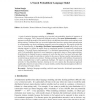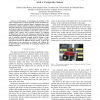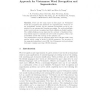250 search results - page 15 / 50 » Learning Probabilistic Models of Word Sense Disambiguation |
116
click to vote
NIPS
2000
15 years 1 months ago
2000
A goal of statistical language modeling is to learn the joint probability function of sequences of words in a language. This is intrinsically difficult because of the curse of dim...
IROS
2009
IEEE
15 years 6 months ago
2009
IEEE
— In this paper, we investigate the problem of 3D object categorization of objects typically present in kitchen environments, from data acquired using a composite sensor. Our fra...
104
click to vote
ACL
2006
15 years 1 months ago
2006
Most approaches to event extraction focus on mentions anchored in verbs. However, many mentions of events surface as noun phrases. Detecting them can increase the recall of event ...
EMNLP
2007
15 years 1 months ago
2007
It has been widely observed that different NLP applications require different sense granularities in order to best exploit word sense distinctions, and that for many applications ...
113
click to vote
ACIIDS
2010
IEEE
15 years 5 months ago
2010
IEEE
There are two main topics in this paper: (i) Vietnamese words are recognized and sentences are segmented into words by using probabilistic models; (ii) the optimum probabilistic mo...



